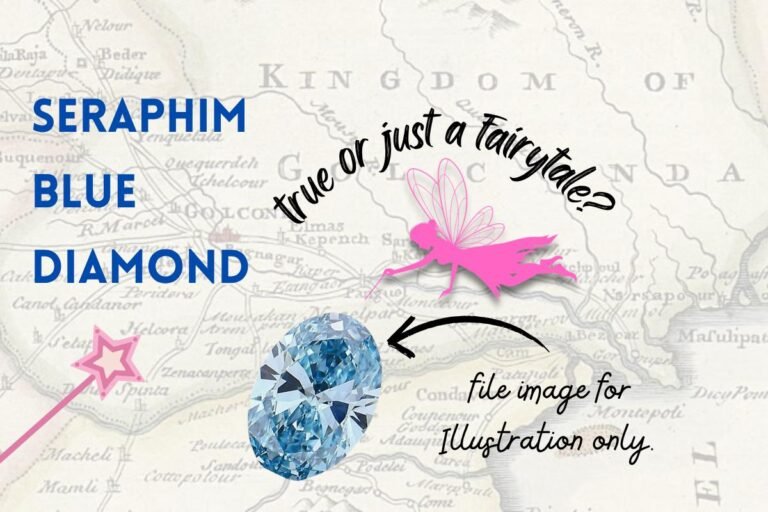A fine blue diamond from the famed Golconda diamond mines has not been seen at a high-profile auction for a long. This was to be expected considering the fact that no high-quality diamond had been retrieved from the Golconda mines for a few centuries. The shocking auction cancellation by reputed auction house Christies in May 2025 increased interest in the Seraphim Blue Diamond. This was a highly touted auction for the Golconda Blue Diamond, which claimed to be mined in Golconda. Interestingly, the provenance was traced back to recent times (1920), and this might have alerted professional diamond collectors.
With rumors about the Seraphim Blue Diamond gaining attention in recent times, the Christie’s auction was at times being confused with the Seraphim Blue Diamond. Confusion was cleared when it was clarified that the Golconda Blue Diamond that was slated to be auctioned and the Seraphim Blue Diamond referred to two different diamonds.
Rumors of the Seraphim Blue Diamond have picked pace in recent times. This is even when the diamond has never been seen at an auction and has remained elusive for a few centuries. There is a common thread that runs across reports published by various sources about the Seraphim Blue Diamond. This is very likely to be the reason why diamond experts hope to see the diamond soon. No secret that such historic diamonds are expected to have related certifications from diamond testing labs – GIA and Gubelin are the labs that auction houses and diamond connoisseurs trust.
The narration for the Seraphim Blue Diamond, compiled here, is based on content extracted from various reports that have been published. So, is the Seraphim Blue Diamond for real? Are we being bombarded with fairy tales? It is best to keep in mind that any information about this diamond is hypothetical until certifications are made available for the diamond and the related story.
It is claimed that the Seraphim Blue Diamond was worn in an opulent turban ornament by the first Nizam of Hyderabad, Asaf Jah 1. The diamond is believed to have a fine blue color and high clarity; most reports seem to agree that it was mined in the Golconda region – probably the Kollur mines. The reign of Asaf Jah 1 as the first Nizam began in 1724; the Nizams took control of the Golconda diamond mines. The story so far seems quite real; the Golconda mines were the most resourceful diamond mines in the days when mining was intense.
Reports claim that Asaf Jah 1 had a fine collection of valuable turban ornaments; most of these had precious stones like ruby, sapphire or diamond as the center stone. There were two turban ornaments adorned with diamonds in the center. The Nizam would wear these only on very special occasions. One of the turban ornaments flaunted a blue diamond, and the other a pink diamond. Details mention that both these fancy color diamonds originated from the Golconda diamond mines. Not much was heard about these diamond turban ornaments after the reign of the first Nizam ended.
Some learned historians are quick to point out that there was never a mention of the two diamond turban ornaments when the final count of the Nizam’s treasury was made in 1948. That was the year when India took over Hyderabad and made it a part of India. Few can doubt this statement; most of the reports detailing the Seraphim Blue Diamond are in line with the historians. The narrative claims that the Seraphim Blue Diamond was handed over to the French. This is by Asaf Jah 2, the second Nizam of Hyderabad. Very few reports suggest that the Nizam ‘gifted’ the rare diamond to the French. The louder claim is that the Nizam negotiated military support from the French, and the Seraphim Blue Diamond was, apparently, handed over to ‘pay’ for that help.
Keeping the fact that the Seraphim Blue Diamond has never made a public appearance in perspective, both diamond collectors and auction houses are likely to be following these rumors without forming any convincing opinions. It is with this mindset that, answers for the current location of the blue diamond are being heard. Rumors suggest that the Seraphim Blue Diamond is now part of a Russian collection. A few reports have stopped short of being very specific and claim that the historic diamond is now in Europe.
So, is the Seraphim Blue Diamond real, or is it just the subject of a fascinating fairy tale? The answer is quite straightforward. While a diamond expert would see nothing unbelievable in the entire story – there is no substitute for reliable certifications and the actual diamond!
